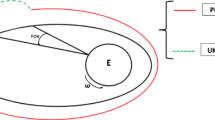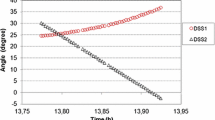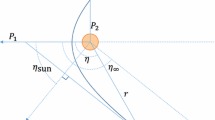Abstract
The number of resident space objects (RSOs) in orbit has increased dramatically within the last 10 years. While RSOs pose a serious challenge to our continued use of space, these objects also provide an opportunity to improve on-orbit state estimation by detecting and identifying these objects using star trackers. While star trackers are currently used to determine the orientation of their host spacecraft, their utility could be expanded to both position and orientation estimation by harnessing RSO detections. In order for RSO-based optical navigation to be commercially viable, a reliable filter covariance estimate is required. This paper introduces an Unscented Kalman Filter (UKF) for estimating an observing spacecraft’s position and attitude based on RSO observations. To ensure that this filter is reliable, a new assessment technique is introduced where we compare the moving standard deviation and mean of the filter’s estimate error with the predicted error based on the filter’s covariance estimate. We demonstrate the utility of this assessment method by comparing the covariance trusts for our UKF and a previously developed Extended Kalman Filter.



Similar content being viewed by others
References
Anheier NC, Chen C (2014) A new approach to space situational awareness using small ground-based telescopes. Tech. Rep. No. PNNL- 23994, Pacific Northwest National Laboratory, Richland, WA, https://doi.org/10.2172/1171901
Brown RG, Hwang PYC (1997) Introduction to random signals and applied Kalman filtering, 3rd edn. Wiley, New York, p 204
Clemens S, Lee R, Harrison P, Soh W (2018) Feasibility of using commercial star trackers for on-orbit resident space object detection. In: AMOSTech Conf., Maui, HI
Crassidis JL, Alonso R, Junkins JL (2000) Optimal attitude and position determination from line-of-sight measurements. J Astronaut Sci 48(2):391–408
Darling J, Houtz N, Frueh C, DeMars K (2016) Recursive filtering of star tracker data. In: AIAA/AAS Astrodynamics Specialist Conf., Long Beach, CA
Driedger M, Ferguson P (2018) Orbital navigation using resident space object observations. In: Proceedings of the 2018 Small Satellite Conf., Logan, UT
Enright J, Jovanovic I, Kazemi L, Zhang H, Dzamba T (2018) Autonomous optical navigation using nanosatellite-class instruments: a Mars approach case study. Celest Mech Dyn Astr. https://doi.org/10.1007/s10569-017-9800-x
Ferguson P (2003) Distributed estimation and control technologies for formation flying spacecraft. PhD thesis, Massachusetts Institute of Technology, Cambridge MA. Retrieved from http://hdl.handle.net/1721.1/82763
Ferguson P (2018) Making space for everyone: a research program aimed at breaking down barriers to new technology adoption in space. In: CASI ASTRO, Quebec City, PQ
Ferguson P, How J (2003) Decentralized estimation algorithms for formation flying spacecraft. In: Proceedings of AIAA Guidance, Navigation and Control Conf., Austin, TX, https://doi.org/10.2514/6.2003-5442
Gelb A, Kasper JF, Nash RA, Price CF, Sutherland AA (1974) Applied optimal estimation. MIT press, Cambridge, MA, pp 182–189
Hoag DG (1983) The history of Apollo onboard guidance, navigation, and control. J Guid 6(1):4–13. https://doi.org/10.2514/3.19795
Julier SJ (2002) The scaled unscented transformation. In: Proceedings of the 2002 American Control Conf., Anchorage, AK, https://doi.org/10.1109/ACC.2002.1025369
Julier SJ, Uhlmann JK (1997) A new extension of the Kalman filter to nonlinear systems. In: The Proceedings of AeroSense: The 11th International Symposium on Aerospace/Defense Sensing, Simulation and Controls, Orlando, FL
Junkins JL, Hughes DC, Wazni KP, Pariyapong V (1999) Vision based navigation for rendezvous, docking and proximity operations. In: 22nd Annual AAS Guidance and Control Conf., Breckenridge, CO
ed K Fletcher (2017) Space debris: the ESA approach. Tech. rep., European Space Agency, available at: http://esamultimedia.esa.int/multimedia/publications/BR-336/. Accessed 2 Feb 2020
Liou JC, Matney MJ, Anz-Meador PD, Kessler D, Jansen M, Theall JR (2001) The new NASA orbital debris engineering model ORDEM2000. Proc Third Eur Conf Space Debris 473:309–313
Owen J W, Dumont PJ, Jackman CD (2012) Optical navigation preparations for New Horizons Pluto flyby. In: 23rd International Symposium on Space Flight Dynamics, Pasadena, CA
Park CW, Ferguson P, Pohlman N, How JP (2001) decentralized relative navigation for formation flying spacecraft using augmented CDGPS. In: Proceedings of Institute of Navigation GPS Conf., Salt Lake City, UT
Riedel J, Owen J W, Stuve J, Synnott S, Vaughan R (1990) Optical navigation during the Voyager Neptune encounter. In: AIAA Astrodynamics Conf., Portland, OR, https://doi.org/10.2514/6.1990-2877
Riesing K, Cahoy K (2015) Orbit determination from two line element sets of ISS-deployed cubesats. In: 29th Annual AIAA/USU Conf. on Small Satellites, Logan, UT
Rososhansky M (2017) Nonlinear attitude and formation estimation spacecraft and multi-agent systems. PhD thesis, Ryerson University, Toronto, ON. Retrieved from https://digital.library.ryerson.ca/islandora/object/RULA:6905
Simon D (2006) Optimal state estimation: Kalman, H infinity, and nonlinear approaches, John Wiley and Sons, chap 13: nonlinear Kalman filtering, p 400
Sinclai D (2017) Second generation star tracker (ST-16RT2). Tech. rep, Sinclair Interplanetary, Toronto, ON
Wan EA, van der Merwe R (2000) The unscented Kalman filter for nonlinear estimation. In: Proceedings of the IEEE 2000 Adaptive Systems for Signal Processing, Communications, and Control Symp., Lake Louise, AB
Wan EA, van der Merwe R (2001) Kalman filtering and neural networks. Wiley., chap Chapter 7 The Unscented Kalman Filter, pp 221–280. https://doi.org/10.1002/0471221546.ch7
Acknowledgements
The authors would like to thank the Natural Sciences and Engineering Research Council (NSERC) of Canada, the Canadian Space Agency, and Magellan Aerospace for supporting this research.
Author information
Authors and Affiliations
Corresponding author
Rights and permissions
About this article
Cite this article
Driedger, M., Rososhansky, M. & Ferguson, P. Unscented Kalman filter-based method for spacecraft navigation using resident space objects. AS 3, 197–205 (2020). https://doi.org/10.1007/s42401-020-00055-w
Received:
Revised:
Accepted:
Published:
Issue Date:
DOI: https://doi.org/10.1007/s42401-020-00055-w




